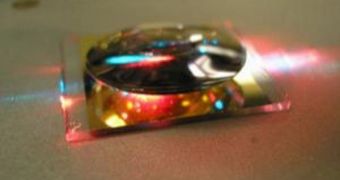In an accomplishment that is bound to make others in the community jealous, scientists at the Towson University, in Baltimore, Maryland, managed to develop a method of trapping rainbows. In addition to looking absolutely astounding, the new system may also usher in a new era of developments in the fields of communications and optical computing, as it may offer researchers a new method of coding information on light. Converting data from optical to electrical environments is the most difficult thing to do in the latter industry, and the new system, featuring only light and a lens, promises an affordable, low-cost, and effective solution to the problem, NewScientist reports.
Optical computers are something that scientists have been working on just as avidly as on their quantum counterparts. The reason for this is the fact that the devices promise to be far faster and more effective in terms of data transfers than existing technologies. But trapping, stopping or even slowing down light has proven to be very complicated. This is a step that is absolutely necessary in order to be able to transcribe information on photons, the basic, elementary particles that make up the electromagnetic radiation, scientists say.
The TU team built its achievement on a 2007 proposal by University of Surrey scientist Ortwin Hess. The expert was the first to propose a tapered waveguide, which was to be constructed in such a manner that light would be forced to stop. The space inside the guide would be so small that not even photons could pass through. The British expert said at the time that this would lead to the creation of a “trapped rainbow.” The instrument was now designed in the United States, by a team led by scientist Vera Smolyaninova. The team used nothing but a convex lens in order to create the waveguide.
The lens, which is no more than 4.5 millimeters in diameter, is coated on one side with a 30-nanometer-thick, gold film. That side is then placed atop a flat surface, which is also covered with a gold, thin film. When analyzed from an edge-on vantage point, the space between the two gold layers narrows down progressively, until it reaches a zero thickness. This, in effect, means that a tapered waveguide has been produced. “I think it's beautiful that we can create such complex phenomena using a very, very simple configuration. It's amazing,” Smolyaninova says of the work.

 14 DAY TRIAL //
14 DAY TRIAL //